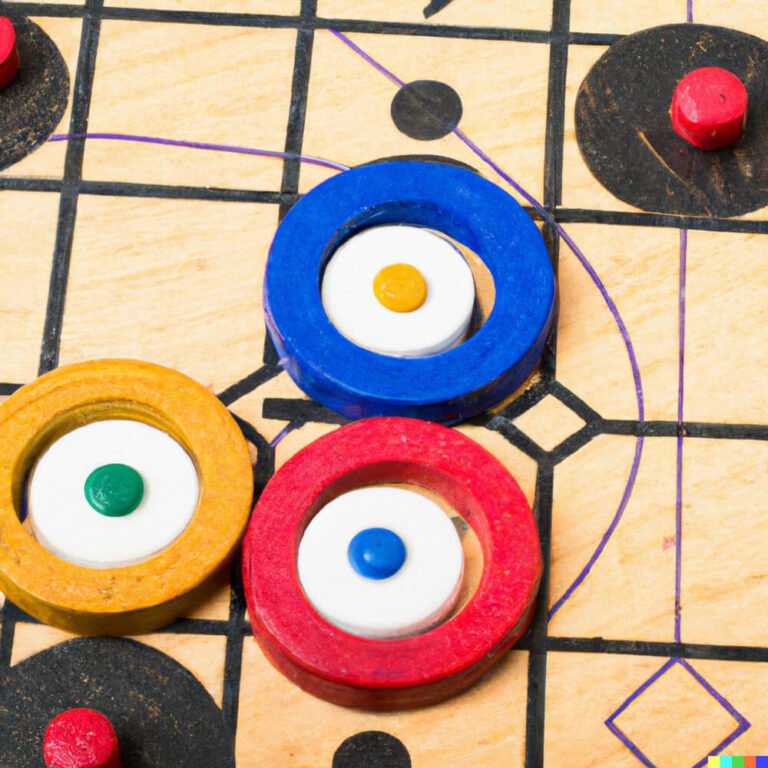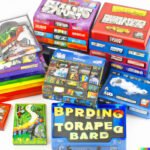Are you ready to delve into the world of classic dungeon board games? If you’re new to the genre or looking to sharpen your skills, this cheat sheet is the perfect guide for you. Classic dungeon board games have been a beloved pastime for decades, offering players an immersive experience filled with adventure, strategy, and excitement.
These games often take place in dark and treacherous dungeons, where players must navigate through traps, monsters, and hidden treasures. Titles like Dungeons & Dragons, HeroQuest, and Warhammer Quest are just a few examples of classic dungeon board games that have captured the hearts of players around the world.
In this article, we will explore the origins and evolution of classic dungeon board games, from their humble beginnings to their current popularity. We will delve into the game mechanics that define this genre and provide valuable tips and strategies for excelling at these challenging games.
And of course, we will provide a comprehensive cheat sheet that includes quick reference charts for common actions, item lists, and combat resolutions. So grab your dice and embark on an epic journey as we uncover the secrets of classic dungeon board games.
History of Classic Dungeon Board Games
Classic dungeon board games have a rich history that dates back to the early 1970s when the first titles in this genre began to emerge. These games typically involve players navigating through a dungeon or other dangerous setting, battling monsters, and collecting treasures while attempting to achieve specific objectives. The appeal of classic dungeon board games lies in their immersive storytelling, strategic gameplay, and cooperative elements.
Origins of Classic Dungeon Board Games
The origins of classic dungeon board games can be traced back to tabletop role-playing games such as Dungeons & Dragons, which was first published in 1974. These early games laid the foundation for the dungeon-crawling gameplay that would come to define the classic dungeon board game genre. Players were tasked with exploring labyrinthine dungeons, engaging in combat encounters, and interacting with various non-player characters within the game world.
Evolution and Influential Titles
As classic dungeon board games gained popularity, numerous influential titles were released that helped shape the genre into what it is today. One of the most iconic games in this genre is “HeroQuest,” which was first published in 1989 and introduced many players to classic dungeon-crawling gameplay.
Other influential titles include “Descent: Journeys in the Dark,” “Gloomhaven,” and “Betrayal at Baldur’s Gate.” These games introduced new mechanics, storytelling elements, and innovative gameplay features that have had a lasting impact on the evolution of classic dungeon board games.
Overview of Game Mechanics
Classic dungeon board games are known for their immersive gameplay, strategic decision-making, and captivating storytelling. These games typically involve players taking on the roles of adventurers exploring dungeons, battling monsters, and collecting loot. Understanding the basic rules, objectives, and gameplay mechanics is essential for both new and experienced players to fully enjoy these classic dungeon board games.
Basic Rules
In classic dungeon board games, players will move their characters through a series of interconnected rooms within a dungeon. Each room may contain traps, treasure chests, or enemies to encounter. The game will have specific rules dictating how characters can move and interact with these elements. This often involves rolling dice to determine movement distances or combat outcomes.
Objectives
The primary objective of most classic dungeon board games is to explore the dungeon, defeat powerful bosses or monsters, and collect valuable items or artifacts. Players may also need to work together to overcome challenges while competing against each other to be the most successful adventurer in the end.
Gameplay Mechanics
Common gameplay mechanics in classic dungeon board games include character customization through character creation or selection at the beginning of the game. Additionally, resource management such as health points, magical abilities, and inventory management plays a crucial role in determining one’s success within the game. Combat mechanics that involve dice rolls or card draws are also prevalent in these games as players face off against various foes throughout their adventure.
Understanding these fundamental aspects of classic dungeon board games sets the stage for an enjoyable gaming experience while providing players with a solid foundation to build upon when developing strategies and tactics for success within the game.
Common Player Strategies
Classic dungeon board games are known for their intricate gameplay and strategic depth. To excel at these games, players need to carefully consider their character selection, resource management, and combat tactics. When selecting a character, it’s important to consider the strengths and weaknesses of each option. Some characters may excel in combat but have limited abilities outside of battle, while others may be versatile but lack the raw power of other options.
Resource management is also crucial in classic dungeon board games. Whether it’s gold, items, or spells, managing resources effectively can mean the difference between victory and defeat. Players should prioritize their resources based on their character’s strengths and playstyle. For example, if a character relies heavily on magical abilities, it may be wise to invest in spells and mana potions.
Combat tactics play a central role in classic dungeon board games. Knowing when to attack, defend, or use special abilities can significantly impact the outcome of battles. Players should also be mindful of positioning on the game board and take advantage of environmental elements or obstacles to gain an edge in combat.
Overall, mastering these player strategies is essential for excelling at classic dungeon board games. By carefully considering character selection, resource management, and combat tactics, players can increase their chances of success and enjoy a more rewarding gaming experience.
| Player Strategy | Description |
|---|---|
| Character Selection | Consider strengths and weaknesses of each option. |
| Resource Management | Prioritize resources based on character’s strengths. |
| Combat Tactics | Know when to attack, defend or use special abilities. |
Classic Dungeon Board Game Cheat Sheet
Classic dungeon board games are a popular genre known for their immersive and challenging gameplay. In these games, players take on the role of characters entering a dungeon or other dangerous environment, where they must navigate hazards, battle monsters, and collect treasure. Some of the most well-loved titles in this genre include “Dungeons & Dragons,” “HeroQuest,” and “Descent: Journeys in the Dark”.
One of the key aspects that sets classic dungeon board games apart is their focus on strategic decision-making and character development. Players must carefully manage their resources, choose the right actions at the right time, and work together to overcome obstacles. Combat is often a significant component of these games, requiring players to use tactics and careful planning to defeat powerful foes.
To excel at classic dungeon board games, players need to understand the game mechanics and develop effective strategies. Character selection is an important decision, as different characters have unique abilities and strengths. Resource management is also crucial, as players must make the most of limited supplies while exploring dangerous environments.
In addition to understanding basic gameplay mechanics and developing effective strategies, having a comprehensive cheat sheet can be incredibly valuable for players of classic dungeon board games. These cheat sheets typically include quick reference charts for common actions, item lists to help keep track of equipment and inventory, and combat resolutions to streamline combat encounters. With this valuable resource at hand, players can spend less time looking up rules and more time enjoying the game.
| Common Actions | Item Lists | Combat Resolutions |
|---|---|---|
| Movement | Weapons | Attacking |
| Exploration | Armor | Defending |
Expansion Packs and Variants
Classic dungeon board games often come with expansion packs and variant rules that can enhance the gaming experience, adding new layers of complexity, scenarios, and challenges. Here are some common expansion packs and variant rules available for classic dungeon board games:
- New Character Classes: Many expansion packs introduce new character classes or characters with unique abilities, adding variety to the game and allowing players to explore different play styles.
- Additional Scenarios: Expansion packs often include new scenarios or quests for players to embark on. These can range from simple fetch quests to epic storylines that span multiple sessions, providing additional content and replay value.
- Variant Rulesets: Some classic dungeon board games offer variant rule sets that allow players to customize their gameplay experience. This can include adjusting difficulty levels, adding new mechanics, or introducing competitive or cooperative modes.
When considering expansion packs and variant rules for classic dungeon board games, it’s important for players to carefully read the descriptions and reviews of these add-ons. This will help them determine which expansions or variants best suit their preferences and play style.
Popular Classic Dungeon Board Games
When it comes to classic dungeon board games, there are several titles that have captured the hearts of players for generations. These games often feature immersive fantasy settings, epic quests, and strategic gameplay that keeps players coming back for more. Below are some of the most beloved classic dungeon board games, each offering its own unique world, characters, and mechanics:
1. Dungeons & Dragons: This iconic game is known for its rich lore and customization options. Set in a high-fantasy world filled with magical creatures and mighty heroes, Dungeons & Dragons allows players to create their own characters and embark on epic adventures.
2. HeroQuest: With its mix of tactical combat and exploration, HeroQuest has been a favorite among fans of classic dungeon board games since its release in the 1980s. Players take on the roles of brave warriors, wizards, and elves as they battle through treacherous dungeons in search of hidden treasures.
3. Warhammer Quest: Set in the dark and gritty Warhammer universe, Warhammer Quest challenges players to lead a party of adventurers through perilous dungeons teeming with monsters and traps. The game’s deep character progression system and intense battles make it a standout in the genre.
These classic dungeon board games offer players a chance to step into fantastical worlds filled with danger and adventure. The combination of immersive settings, memorable characters, and engaging gameplay mechanics has cemented these titles as enduring favorites among board game enthusiasts.
Community and Resources
In conclusion, the world of classic dungeon board games is a rich and diverse one, offering players a wide variety of experiences and challenges. From the early days of Dungeons & Dragons to modern titles like Gloomhaven, the genre has continued to evolve and captivate gamers for decades. As we have seen in this article, understanding the history and game mechanics of classic dungeon board games can greatly enhance a player’s enjoyment and success in these adventures.
For those looking to dive deeper into the world of classic dungeon board games, there are numerous resources available to support and guide them. Online communities and forums provide a platform for players to connect with each other, share strategies, ask questions, and discuss their favorite games. Whether you’re a seasoned veteran or a newcomer to the genre, engaging with these communities can offer valuable insights and foster a sense of camaraderie among fellow enthusiasts.
Additionally, there are many online resources such as websites, blogs, and social media accounts dedicated to classic dungeon board games. These platforms often feature in-depth articles, videos, reviews, and tutorials that can help players improve their skills, stay updated on new releases, and discover hidden gems within the genre.
By taking advantage of these resources, players can deepen their appreciation for classic dungeon board games while expanding their knowledge and expertise. So whether you’re seeking tips for mastering combat tactics or looking to learn about the latest expansion packs and variants, the online community has plenty to offer to enrich your gaming experience.
Frequently Asked Questions
How Many People Can Play Dungeon Board Game?
In most Dungeon board games, the number of players can vary. Some games are designed for 2-4 players, while others may be suitable for larger groups of 5 or more. The exact number of players will typically be specified in the game’s instructions or description.
What Is the Board Game Where You Escape a Dungeon?
The board game where you escape a dungeon is often referred to as a “dungeon crawl” game. In these types of games, players take on the roles of adventurers navigating through a labyrinthine dungeon filled with traps, monsters, and treasures, all while attempting to find their way out to safety.
Is Darkest Dungeon a Board Game?
Darkest Dungeon is not a traditional board game; rather, it originated as a video game available on various platforms. It is a challenging gothic roguelike turn-based RPG that focuses on the psychological stress experienced by adventuring heroes as they battle through monstrous nightmares and cosmic horrors.
However, due to its popularity and engaging gameplay mechanics, it would not be surprising if someone developed a board game adaptation in the future based on this IP.

I love playing all kinds of games – from classics like Monopoly to modern favourites like Ticket to Ride.
I created this blog as a way to share my love of board games with others, and provide information on the latest releases and news in the industry.





